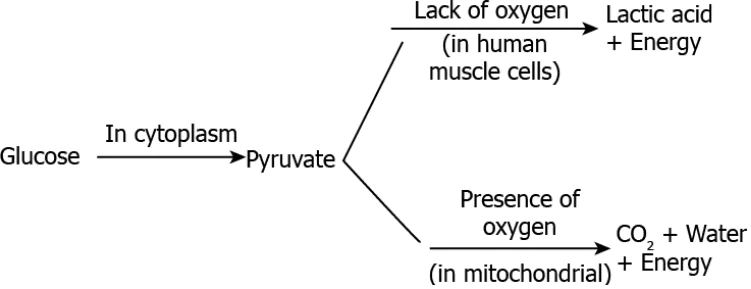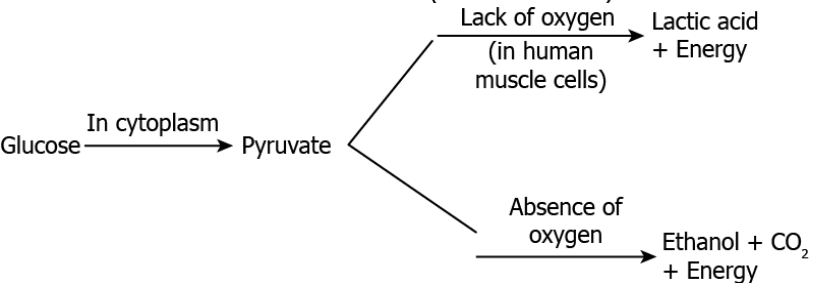Hint: Explain the process of absorption of CO_{2} & H_{2}O , in order to understand how autotrophs obtain substances necessary for nutrition.
Question.1. The image shows the process of making food by a plant.
(a) plants absorb CO_{2} from air and H_{2}O from the soil as raw materials and convert them into glucose
(b) plants absorb CO_{2} from the soil and H_{2}O from air as raw materials and convert them into glucose
(c) plants absorb O_{2} from air and glucose from the soil as raw materials and convert them into light energy
(d) plants absorb O_{2} from air and minerals from the soil as raw materials and convert them into heat energy
Question.2. A student sets up an experiment to study the importance of nutrition in plants. The student takes 2 pots, pot 1 and pot 2 each with the same healthy plant. Both the pots were placed in the garden and watered properly. Pot 1 was kept as such, while pot 2 was kept in an air tight glass box with caustic soda. Caustic soda absorbs carbon dioxide present in the surrounding. After 2 days, the student observes that the plant kept in the garden is healthy while the plant placed in container shed leaves and droops. What is the likely reason for this observation?
(a) lack of nutrients in the soil
(b) absence of oxygen for survival
(c) inability to perform photosynthesis
(d) absorption of light by caustic soda restricting growth
Ans.1. (a) plants absorb CO_{2} from air and H_{2}O from the soil as raw materials and convert them into glucose
Ans.2. (c) inability to perform photosynthesis
Hint: Explain the process of conversion of CO_{2} & H_{2}O into carbohydrates, in order to understand how autotrophs obtain nutrition.
Question.3. Which of the equation show correct conversion of CO_{2} and H_{2}O into carbohydrates in plants?
(a) 


Question.4. A student sets up an experiment to study the photosynthesis in plants. The student de-starched a potted plant by keeping it in a dark room for 3 days. Half of the portion of de-starched leaf was placed in a bottle containing caustic potash (absorbs CO_{2} ) as shown.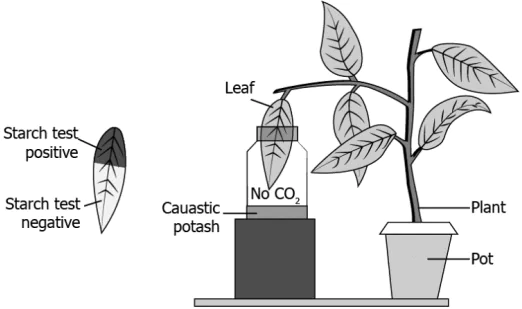
(a) carbon dioxide is directly linked with the colour of leaf
(b) carbon dioxide is necessary for preparing carbohydrate
(c) lack of carbon dioxide increases amount of starch in plant
(d) lack of carbon dioxide slows the process of photosynthesis
Ans.3. (c) 
Hint: List and explain the strategies employed by heterotrophs to take up food, in order to understand how heterotrophs obtain nutrition.
Question.5. The image shows the bread moulds on a bread. 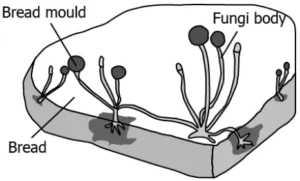
(a) by eating the bread on which it is growing
(b) by using nutrients from the bread to prepare their own food
(c) by breaking down the nutrients of bread and then absorbing them
(d) by allowing other organisms to grow on the bread and then consuming them
Question.6. The image shows how Amoeba obtains nutrition. 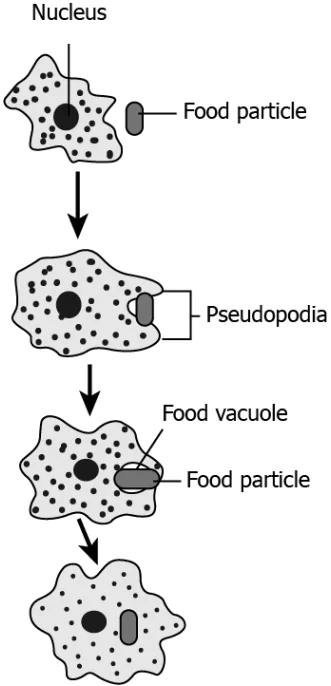
(a) capturing of food takes less time
(b) complex food can be digested easily
(c) more amount of food can be consumed
(d) fast distribution of nutrition within the body
Ans.5. (c) by breaking down the nutrients of bread and then absorbing them
Ans.6. (d) fast distribution of nutrition within the body
Hint: Illustrate the process involved in human digestive system, in order to explain how humans obtain nutrients from food.
Question.7. The image shows the human digestive system.
(a) mouth due to the presence of saliva
(b) oesophagus that moves the food in gut
(c) that releases juices for fat breakdown
(d) which helps in mixing food with digestive juices
Question.8. The image shows a cross section of small intestine.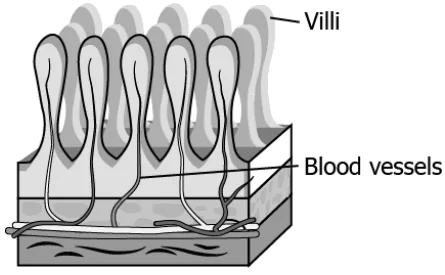
(a) increase in the absorption of food
(b) fast elimination of waste from the body
(c) increase in flow of blood in the small intestine
(d) fast breakdown of larger food particles into smaller ones
Ans.7. (a) mouth due to the presence of saliva
Ans.8. (a) increase in the absorption of food
Hint: List the enzymes & their functions involved in human digestive system, in order to understand breakdown of food in humans.
Question.9. An incomplete equation for the digestion of starch using saliva is shown as:
Saliva + Starch (in test tube) →
What will be the likely outcome of this?
(a) Saliva will convert starch into complex fat molecules.
(b) Saliva will convert starch into complex sugar molecules.
(c) Saliva will breakdown starch into simple sugar molecules.
(d) Saliva will breakdown starch into simple protein molecules.
Question.10. A student sets up an experiment to study the role of enzymes in digestion of food. 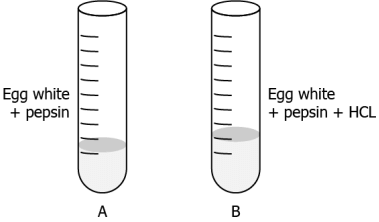
(a) Test tube A as pepsin will breakdown into simple molecules.
(b) Test tube B as HCl will breakdown protein into simple molecules.
(c) Test tubes A as pepsin will breakdown protein into simple molecules.
(d) Test tube B as HCl will activate pepsin for breakdown of protein into simple molecules.
Ans.9. (c) Saliva will breakdown starch into simple sugar molecules.
Ans.10. (b) Test tube B as HCl will breakdown protein into simple molecules.
Hint: Outline and explain the ways of breakdown of glucose by various pathways, in order to explain how energy is obtained in organisms.
Question.11. The image shows the flow diagram for the breakdown of glucose in yeast. 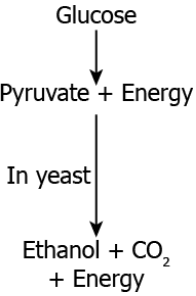
(a) in the presence of oxygen
(b) in the absence of oxygen
(c) the presence of carbon dioxide
(d) in the absence of carbon dioxide
Question.12. Which pathway will occur in the cell of an athlete who is performing 100m sprint?
(a) 

(d)
Ans.11. (b) in the absence of oxygen
Ans.12. (c)
Hint: Illustrate the process involved in human respiratory system, in order to explain how humans take in oxygen and expel CO_{2} .
Question.13. A student setup an experiment to study the human respiratory system. In the experiment, the student places candle and a living cockroach in the flask A, while a candle and a dead cockroach in flask B. The burning of candle needs oxygen.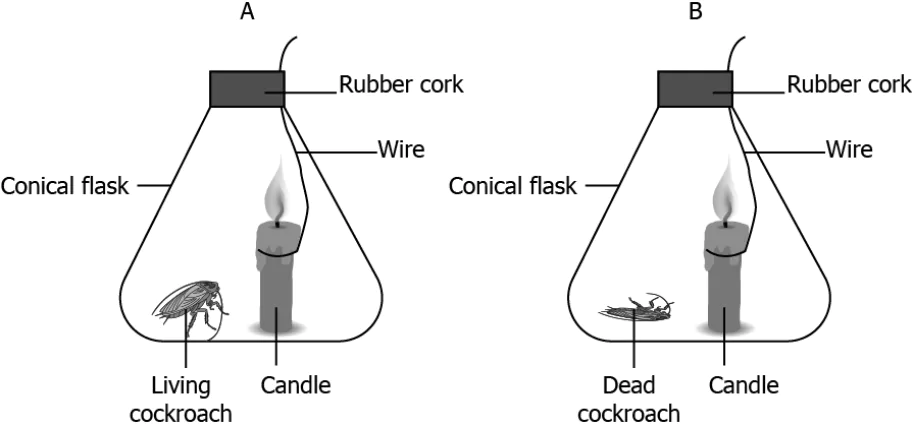
(a) candle produces high amount of carbon dioxide
(b) living beings consumes oxygen during respiration
(c) burning of candle decreases the life span of cockroach
(d) water vapours produced by living beings prevents burning of candle
Question.14. A student sets up an experiment to study human respiration using lime water, test tube and a straw. Lime water is colourless in the absence of CO_{2} and is milky in its presence. The student fills a freshly prepared limewater in a test tube and blows air through straw into the limewater. It was observed that the solution turns cloudy as shown.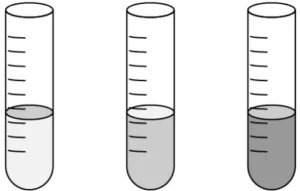
(a) oxygen is exhaled during respiration
(b) glucose is produced during respiration
(c) dioxide is exhaled during respiration
(d) water vapours are produced during respiration
Ans.13. (b) living beings consumes oxygen during respiration
Ans.14. (c) dioxide is exhaled during respiration
Hint: Illustrate the process of transport of oxygenated & de-oxygented blood by human heart, in order to explain how oxygen is transported to cells.
Question.15. The image shows the transport of gases in body through heart and lungs.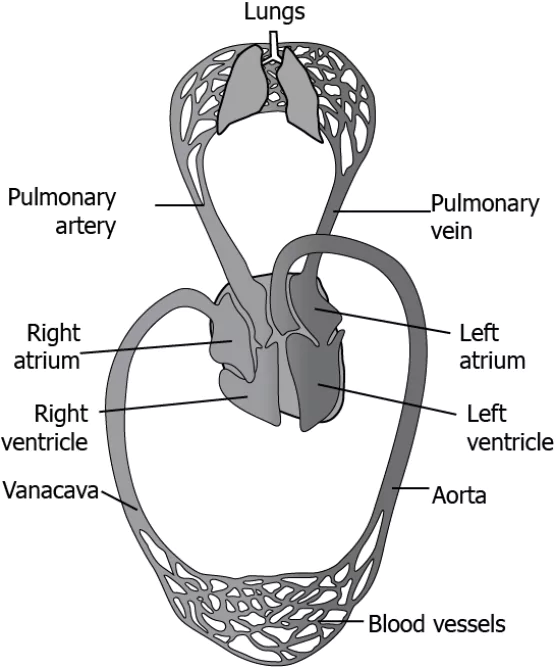
(a) Lungs → pulmonary vein → left atrium → left ventricle → aorta → body cells
(b) Lungs → pulmonary vein → right atrium → right ventricle → aorta → body cells
(c) Lungs → pulmonary artery → left atrium → left ventricle → vanacava → body cells
(d) Lungs → pulmonary artery → right atrium → right ventricle → vanacava → body cells
Question.16. The image shows oxygenated and de-oxygenated blood in the human heart.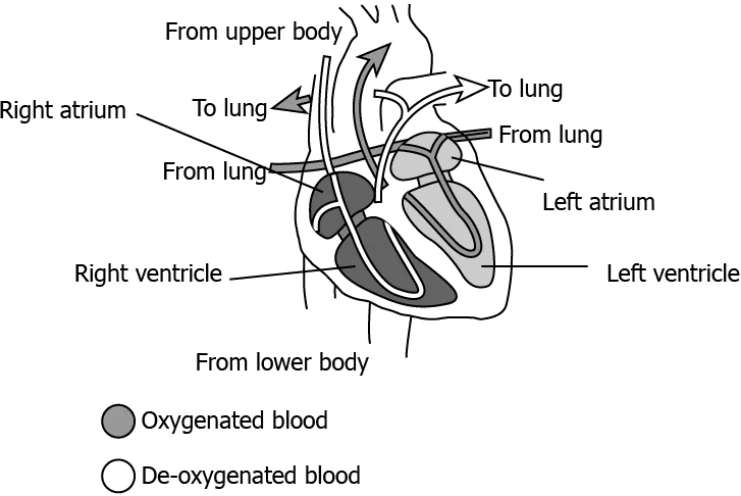
(a) towards the lungs
(b) towards the lower body
(c) towards the upper body
(d) towards the left atrium of heart
Ans.15. (a) Lungs → pulmonary vein → left atrium → left ventricle → aorta → body cells
Ans.16. (a) towards the lungs
Hint: Outline the process of double circulation of blood in fishes, in order to explain how oxygenated & de-oxygenated blood is compartmentalized.
Question.17. The image shows the circulation of blood in fishes.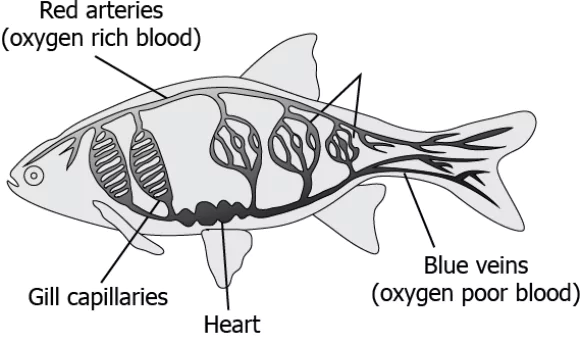
(a) Gill capillaries → oxygenated blood → heart → body cells → deoxygenated blood → gills
(b) Gill capillaries → oxygenated blood → body cells → deoxygenated blood → heart → gills
(c) capillaries → heart → oxygenated blood → body cells → deoxygenated blood → heart → gills
(d) Gill capillaries → oxygenated blood → heart → body cells → deoxygenated blood → heart → gills
Question.18. The image shows the circulation of blood in fishes and humans.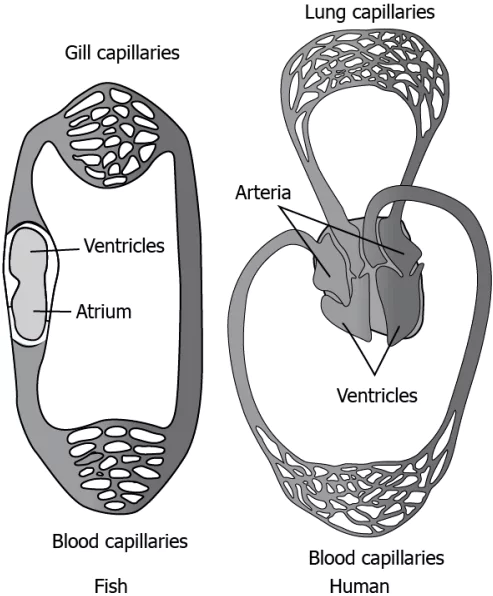
(a) The heart in fish is bigger in size.
(b) The flow of blood in fish is unidirectional.
(c) The blood goes through heart only once in fishes.
(d) The heart of fish has more chambers compared to that of a human.
Ans.17. (b) Gill capillaries → oxygenated blood → body cells → deoxygenated blood → heart → gills
Ans.18. (c) The blood goes through heart only once in fishes.
Hint: Describe the function of blood vessels, arteries, platelets & lymph in human body, in order to understand how human transportation system works.
Question.19. The image shows the structure of an artery.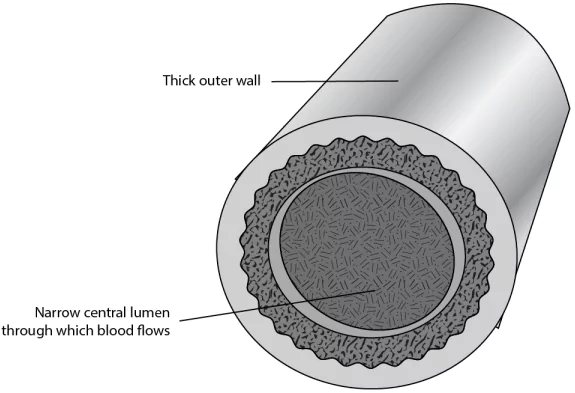
(a) to carry large amount of blood
(b) to allow easy exchange of gases with cells
(c) to ensure blood flows in only one direction
(d) to sustain the high-pressure blood from the heart
Question.20. The image shows the healing of a wound.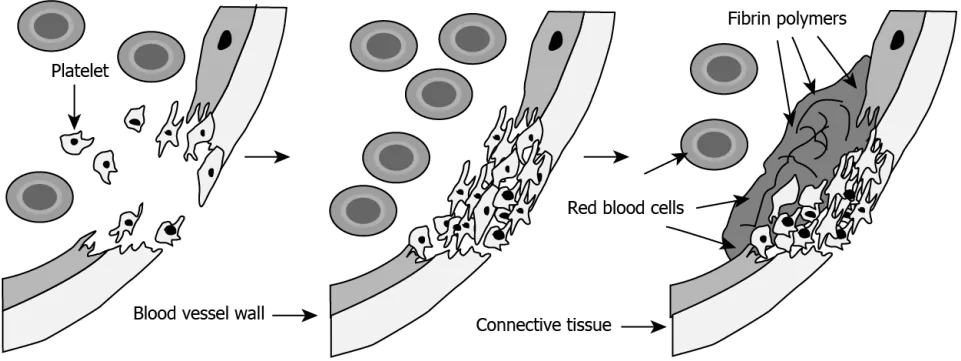
(a) platelets form clot by plugging the site of injury
(b) platelets uses component of broken vessel to form clot
(c) red blood cells divide and replace the broken vessel at the site of injury
(d) red blood cells and platelets migrate to site of injury and secrete substance that forms new vessel
Ans.19. (d) to sustain the high-pressure blood from the heart
Ans.20. (a) platelets form clot by plugging the site of injury
Hint: Explain the function of xylem (vessels and tracheids) in plants, in order to explain how plants take up water from soil.
Question.21. How water is taken up from soil to the xylem tissue of the plant roots?
(a) xylem attracts water molecules
(b) roots act as a suction pump for taking water
(c) soil expels the water with pressure to the xylem
(d) difference in the ion concentration creates a gradient for water movement
Question.22. A student performs an experiment using a balsam plant with intact stem, leaves, roots and flowers. The plant was kept in a test tube containing eosin solution (a pink colour dye). The test tube mouth was covered using cotton plug as shown.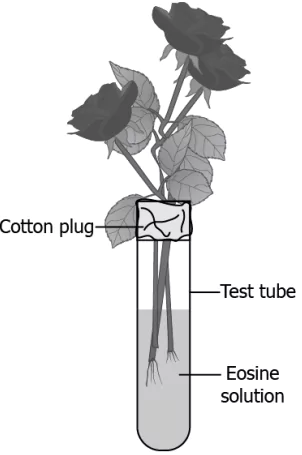
(a) eosin solution gets stored in the xylem
(b) water moves through xylem in the plant
(c) xylem reacts with eosin and gives colour
(d) most portion of the plant stem is occupied by xylem
Ans.21. (d) difference in the ion concentration creates a gradient for water movement
Ans.22. (b) water moves through xylem in the plant
Hint: Explain the function of transpiration in order to explain how water travels up in plants.
Question.23. The loss of water from the leaves of the plant is transpiration. How this process is advantageous for the plant?
(a) It helps in the downward movement of the water.
(b) It helps the plant to maintain temperature in hot sunny days.
(c) It acts as a driving force for distribution of food in plant’s body.
(d) helps maintain a constant level of water in the soil around the plant.
Question.24. A student setup an experiment using a well-watered plant. The plant’s roots and soil were covered with a rubber sheet. The plant was then kept in a glass bell jar and sealed with Vaseline at the bottom part to prevent the flow of air. The student keeps the apparatus in the light and observes water drops inside the jar after 2 hours as shown in the image.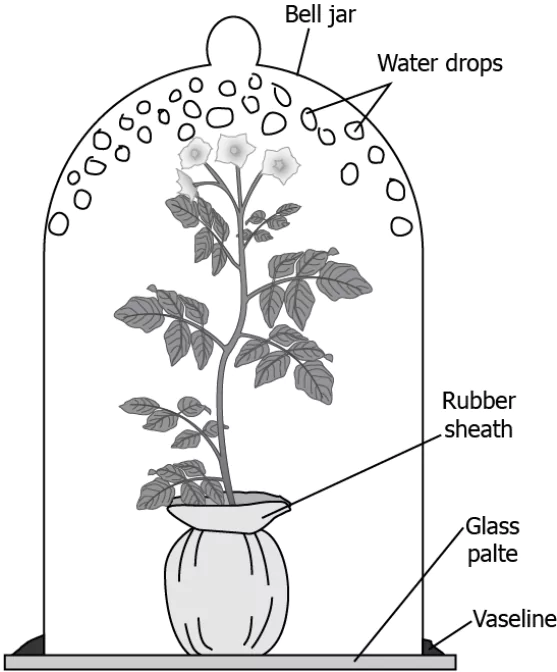
(a) Plant leaves give off water in form of vapours.
(b) Heat from the outside warms the jar which melts the vaseline into vapours.
(c) Plant absorbs water from environment thus extra water appears on the inside of jar.
(d) Covered roots and stem of the plant decreases the temperature of jar resulting in condensation of moisture into vapours.
Ans.23. (b) It helps the plant to maintain temperature in hot sunny days.
Ans.24. (a) Plant leaves give off water in form of vapours.
Hint: Explain the function of phloem & ATP, in order to explain how food is transported in plants.
Question.25. The image shows the transport of food material inside plant body with the help of phloem.
(a) food is transported along with the water in plant’s body.
(b) food is transported in only direction like water in the plant body through xylem.
(c) food is transported from a region with low concentration to higher concentration.
(d) Food is transported from a region where it is produced to other parts of the plants.
Question.26. The image shows the movement of sucrose into phloem against the concentration gradient which also leads to the movement of water due to osmotic difference. This osmotic pressure allows movement of material in plant body.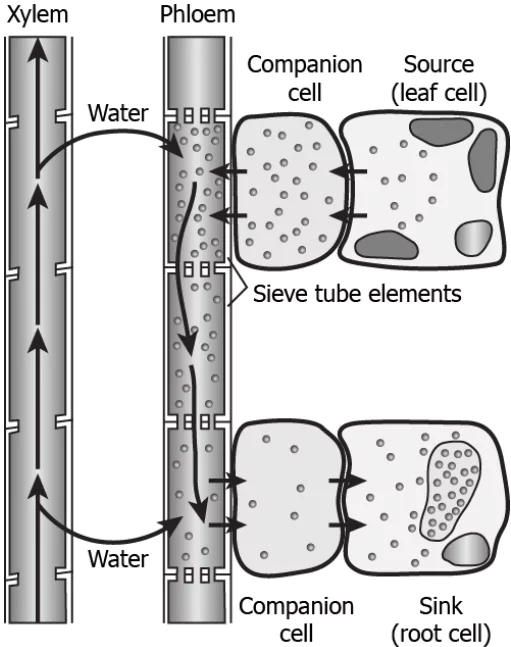
(a) with the help of transpiration
(b) with the help of water gradient
(c) with the help of ATP molecules
(d) with the help of ADP molecules
Ans.25. (d) Food is transported from a region where it is produced to other parts of the plants.
Ans.26. (c) with the help of ATP molecules
Hint: Illustrate the process involved in human excretory system, in order to explain how waste is transported out of humans’ body.
Question.27. The image shows the excretory system in humans.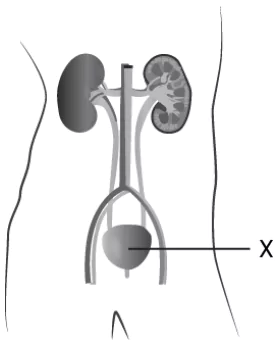
(a) It produces urine.
(b) It filters waste from the blood.
(c) It stores the urine till urination.
(d) It carries urine from kidney to outside.
Question.28. The image shows the structure of a nephron.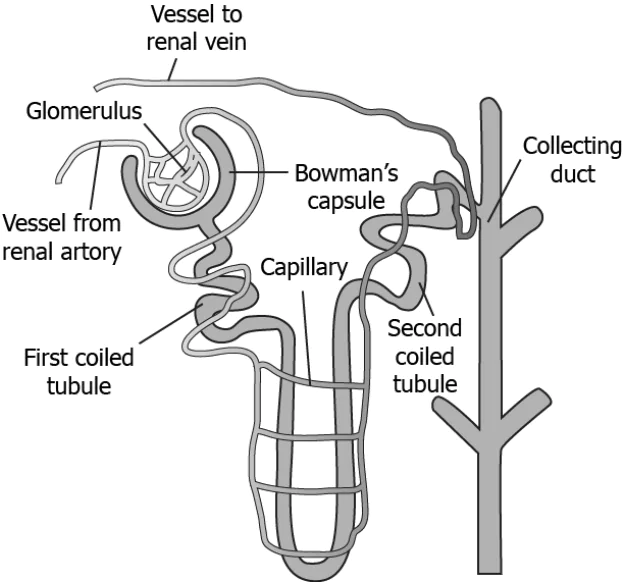
(a) It makes the process of filtration at Bowman’s capsule easier.
(b) It helps keep the output of urine constant throughout the day.
(c) It helps to uptake and store excess amount of water in the body for later use.
(d) It maintains the concentration of urine based on the amount of water present in the body.
Ans.27. (c) It stores the urine till urination.
Ans.28. (d) It maintains the concentration of urine based on the amount of water present in the body.
Hint: Describe transpiration and other ways in which plants shed extra wastes, in order to explain excretion in plants.
Question.29. The image shows the process of photosynthesis in plants.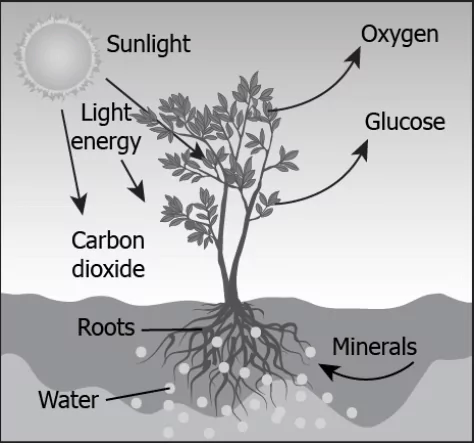
(a) Carbon dioxide
(b) Glucose
(c) Light energy
(d) Oxygen
Question.30. A plant gets rid of excess water through transpiration. Which is a method used by plants to get rid of solid waste products?
(a) shortening of stem
(b) dropping down of fruits
(c) shedding of yellow leaves
(d) expansion of roots into the soil
Ans.29. (d) Oxygen
Ans.30. (c) shedding of yellow leaves



